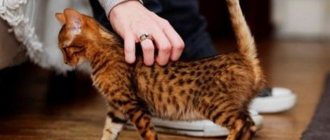People who have never owned cats often ask themselves a lot of questions about cat behavior because they find it difficult to understand and interpret their behavior. In this article, we will answer one of the most frequently asked questions among those just starting out with a cat: Why won't my cat allow herself to be petted?
Especially if you adopted an adult cat, you don't necessarily want to see her as a puppy who needs to be cuddled all the time, otherwise you'll just let him run away more and more every time you try to pet him. Let's look below at the reasons why a cat does not allow itself to be touched.
A cat bites when you pet it: the main reasons
Many cats have an unaffectionate character, let's try to find out the reason for this.
Many people get cats to care for them and pet them. But it is often discovered that the kitten does not like affection, or the craving for it goes away over time. It also happens that an adult animal does not like being touched, which, of course, the owners do not understand.
The reasons why a cat does not like having its fur stroked can be completely different.
Willful and strong-willed character
Many cats have a special character, with their own quirks and advantages.
First of all, it is worth noting that cats, compared to dogs, allow themselves to be stroked less, which is due to the specifics of their behavior.
. As a rule, the cat breed has a more capricious, majestic character. They show that they feel complete and self-sufficient, unlike dogs, who confirm with their docile nature that they are completely dependent on humans.
This behavior in cats appears from a very early age.
It is not difficult to accustom a kitten to affection if it was raised by a cat in public and not on the street. Otherwise, it’s better to wait until the kitten gets used to you and is attracted to you.
Gender plays a significant role
Neutered cats tend to be more affectionate.
As a rule, cats are the most affectionate among cat breeds due to their softer, more flexible nature. As for cats, they often show by their very appearance that they do not need the warmth of human hands.
On the other hand, cats can also be aggressive, for example when feeding their babies.
. As for the males, among them there are many lovers of affection among neutered homebody cats.
Early separation from mother
Early separation from the mother can make the animal more aggressive.
Small kittens often do not allow themselves to be petted.
If separation from the mother occurs early, the kitten will be afraid of you. He will only get used to you over time and will let you pet him.
The fact is that all animals, including kittens, associate humans with danger and threat. As a rule, it is mother cats who accustom kittens to communicate with humans during the first two months of their life.
Negative experience, resentment
It is worth noting that sometimes adult pets can be aggressive due to negative experiences, causing them pain and, consequently, resentment.
This behavior can be caused by many factors
– harsh punishment, claw trimming, post-operative period (for example, castration), injections, etc.
Aggression in cats can be caused by resentment or negative experiences of the cat.
Regarding the postoperative condition, which can cause depression
, then it normalizes over time. This takes an average of 5 days or more (depending on the complexity of the operation and the recovery time of the body).
Under no circumstances should you use violent methods in raising your pet, otherwise he will lose trust in you. In such cases, it is useless to expect warmth from the animal. If your cat behaves badly, you can use various methods of education that are understandable to him, but more loyal, and in no case engage in assault.
“Mongrels” crave warmth and affection
Many pet owners who have adopted stray kittens and cats spend a lot of time teaching the animal to be affectionate.
They all have negative experiences from the street, they can remember a difficult life. Only the love of her owners will help her to forget. Raising a pet you have adopted needs to be done delicately. If you do everything correctly, then after a while he will be drawn to you.
Pregnancy and feeding time
Often pregnant cats, as well as animals that feed kittens, practically do not allow themselves to be stroked.
Owners must understand that during this period the cat needs peace, because feeding the cubs is her main task.
Weasel for kittens - game
Many animals perceive caresses as a signal to play.
It often happens that playful kittens perceive affection as a game.
. Seeing a person's hands, they strive to play. Their behavior will change over time if you buy special toys and jumpers for them.
Birth injury
There are times when a cat’s fetus comes out with difficulty during childbirth.
This results in a slight pinching of the kitten's spine, which usually occurs in the lower back, near the base of the tail.
If you pet a cat in that area, it will not like it. In this case, it is better for the owner to stroke it in other places, for example, the withers, behind the ears. As for the spine, owners should not worry. This is a normal pathology.
Are pets that simple?
Cats are amazing animals that have been close to humans since ancient times. Cats were not tamed like dogs, they were not put in cages like parrots and canaries, they themselves came to a person and settled in his house.
In ancient Egypt and Mesopotamia, a furry predator went for prey in a grain storage facility, where there were many rodents, and that is where it met people. Over time, the person became attached to this animal and was able to study the psychology of cats. The main “sensors” of a cat’s emotions and feelings are their tail and ears, and then only their postures, facial expressions and gestures.
- Ever notice how two cats rear up before a fight?
- The cat defends itself with hissing, raised fur, and an arched pose.
- If a cat continually rubs against his legs, not allowing passage, he clearly lacks attention and affection.
- A plaintive meow can be a signal of some health problems, or a request to eat or drink.
Cats, by the way, are not without cunning and resourcefulness. For example, if during an illness the cat received more attention and affection, then he may realize and begin to pretend to be sick.
Pain and inflammation in cats
Various diseases can also cause a pet’s aggressiveness.
If your cat loves affection, but for obvious reasons has stopped giving it, and can make sounds when you touch them, then the owner should be wary. This behavior may be a sign of poor health or illness in the animal.
. In what cases is this possible:
- the pet, but there is no vomiting - it is better for the owner to wait until the pain goes away;
- abdominal pain with abnormal feces and vomiting, lack of appetite, apathy - a sign of poisoning;
- presence of wounds, scratches on the skin;
- bruises, dislocations, ;
- blocks, ticks, lice-eaters that cause discomfort;
- and urinary system, inflammatory processes in the bladder;
- the development of pathologies in the abdominal organs of the animal.
Diagnostics
To identify a more precise reason why a cat does not allow itself to be petted, you need to monitor its behavior. In most cases, she may simply be in a bad mood, which is quite normal.
If your pet feels unwell for more than a day
, which consists of apathy, lack of appetite, poor stool, abnormal urine output, etc., then this is a good reason to conduct an examination.
Norm or pathology
Sometimes some cats develop mental disorders, but this cannot be detected on their own. For this purpose, it is worth visiting a veterinarian and telling your concerns about changes in the animal’s behavior and the appearance of unmotivated aggression. Only a specialist will be able to determine whether this is related to pathology or is a character trait.
But most often bites are caused by other reasons. Cats are one of the most independent pets and this needs to be taken into account. And everyone's character is different. While some are very affectionate and love attention from their owner, others don’t like it.
Some animals, even living for a long time in a family, try to keep a distance from people and cannot stand a familiar attitude towards their person. These are already individual character traits and it will not be possible to change temperament.
conclusions
Watch your pets and take care of them! Their behavior can tell you a lot.
Natalie Thai, Thai Cat Club
Some cats are completely submissive and allow themselves to be petted as much as they want, as long as their owners are generous with affection. Others, when they get tired of it, begin to break free from their hands, jump off their master’s lap and run away.
But there is another type of cat behavior, and there are many more of these cats than most people believe - they react to what they consider to be excessive affection with aggression: they scratch and bite. The attack is unexpected and completely inexplicable and leaves the owner not only with bleeding wounds, but also deep bewilderment in the soul.
Animal behaviorists even gave this phenomenon a name - petting-induced aggression / overpetting aggression (excessive affection).
Incorrect socialization: problems in education
Representatives of the cat family should be tamed from an early age. It’s even better if you are with the kittens from birth, taking responsibility for the growing animals. Why is this so important?
- Experts say: babies who regularly had contact with a person before 7 weeks of age are more trusting and more willing to participate in games and go into the arms of their owner than strays who do not receive their share of care and love.
- Attention from the owner is the key to proper upbringing. By studying your cat's behavior day after day, you will learn to distinguish features that are invisible to others and prevent brewing “conflicts.”
However, such a theory does not explain why animals that have lived side by side with humans all their lives suddenly become completely uncontrollable.
Aggression caused by affection
Many owners believe that the cat bit or scratched them “unexpectedly,” “suddenly,” “out of the blue.” However, experienced cat owners are able to recognize an impending threat in advance and predict the cat's behavior.
Let's take a closer look at this process together. The owner begins to stroke the cat, ruffle its ears, or lightly scratch its head. The cat responds to affection, relaxes and purrs.
Then after a while we see that the cat tenses impatiently and begins to twist its ears in different directions.
Often, this is where the owner doesn’t notice anything, or even starts stroking harder, trying to calm him down. But this is a signal of danger. At the same moment, the animal’s pupils may dilate.
And the cat, with a quick, almost imperceptible movement, rushes forward with its claws extended and inflicts a wound on the person. In this case, the cat may suddenly and very strongly bite the hand with its teeth. Then he rushes away with lightning speed, as if fleeing in panic.
In essence, this behavior is characteristic of an animal that senses serious danger and defends itself. Having inflicted a wound and expecting immediate reprisal, the cat hurries to hide.
But where does she get the feeling of danger when in contact with an owner who behaves quite peacefully?
Theories explaining affection-induced aggression
There are many theories trying to explain cats' aggressive behavior in response to affection. Let's look at a few of them.
Incorrect socialization
. Cats should be socialized to people from a very early age. Cats that interacted with a person for at least 5 minutes a day before 7 weeks of age will be much more affectionate and trusting than animals that did not meet a person at this age. But this theory does not explain why properly socialized cats sometimes become aggressive towards their owners.
Sensitivity threshold.
According to this theory, cats initially enjoy being petted by people, but then become irritated by it. And when a cat bites or scratches its owner, it is as if it is trying to say “enough is enough.” Here we can draw an analogy with human behavior. Imagine that someone strokes your back in the same place with the same pressure for a long time. At first you like it, but then it begins to cause discomfort and even pain, and you want to move away from that person or ask him to stop.
Pain
. There is a theory that constant petting not only causes irritation in animals, but also physical pain, since the static electricity generated when stroking an animal's fur has a negative effect on its nervous system.
If your cat is in pain and you pet him in that particular area, this can also cause aggressive behavior.
Sharp awakening.
The cat may enjoy the affection and almost fall asleep (although its eyes may remain open). If she suddenly wakes up, she may not realize that you are just petting her, and she may think that you are trying to grab her. Then she will instinctively bite you and run away before she realizes what is happening.
Control
. According to this theory, aggressive behavior is explained by the fact that the cat always strives to maintain control over the situation - when to start stroking it, when to stop, it decides for itself. The cat thus emphasizes its dominant position.
Take your pet to the vet.
It is important to find out if he has any disease that could cause pain. For example, arthritis in the neck, hind or hip joints, sore teeth, ear infections, etc. can cause pain in cats. Stroking the cat may make this pain worse, or the cat may become nervous in fear that you will touch the painful area.
Understand and accept that not all cats like “calf tenderness.”
Each animal is individual. Some people like to communicate with a person, climb into their arms, and endlessly caress them. Others just like to be close to the person, nearby, but they do not need closer contact. You can't change your cat's personality. Accept her for who she is.
Be careful and study your cat's body language!
Perhaps your cat is in the mood to play right now, and not at all to cuddle. In this case, it is better to throw the ball to her. See the article "" and "" for more details.
Here are some warning signs
:
- The cat stopped purring.
- Twitching of the tail.
- Exasperated tail wagging.
- Twitching of the hair on the back after stroking.
- Change of body position.
- Body tension.
- Ears are pressed to the head.
- Dilated pupils.
- Meow.
- Growl.
If you notice any of these signs, stop all your movements and release the cat.
For more information about cat body language, see the article “”.
Forecasting
. If you know that your cat is prone to this type of aggression, then it would be a good idea to time the time during which the cat enjoys your affection. If, for example, your cat shows signs of irritation a couple of minutes after you start petting her, then never pet her for more than a minute and a half (while still watching for warning signs).
Pet your cat the way she likes.
Some cats prefer short, jerky stroking movements, as if another cat is licking their fur. Others like to be scratched under the chin or behind the ear. Still others prefer to be stroked only on the head, to the exclusion of the rest of the body. Some people like to have their tail ironed, but others don’t. Consider your cat's personality preferences.
Sometimes a special contact is established between a cat and a person. For example, a cat may be delighted when one of the family members scratches its chin, but only allows another to stroke it all over its body, and not vice versa. Probably the most striking example is when a cat allows one person to stroke its belly, but not another. Respect your cat's interests and wishes!
Look for options for your individual contact with your pet that will be pleasant for both of you!
Never punish a cat for this, as this can cause even more aggression.
Use training
. If your cat doesn't bite when you pet her, give her a treat, such as a small piece of chicken or another favorite treat. Repeat this action several times a day, stroking the animal little by little, without crossing the threshold of sensitivity. (Stop as soon as you notice signs of irritation.) After a while, the cat will understand that affection is something pleasant, as it is followed by a treat.
The most important advice is to love your cat.
. Even if she bit you or scratched you. Don't take out your irritation or anger on her. Study information on cat behavior and apply it in your life. Be happy with your cat!
Cat owners know firsthand how quickly the behavior and mood of their beloved pet can change. An affectionate and gentle cat can rub its head against a person’s hand, purr and show its positive attitude in every possible way, but after a minute a good-natured animal can turn into a real predator who, for no apparent reason, attacks its owner. Most people are puzzled why a cat bites when you pet it, but there are many reasons for this behavior, each of which has its own explanation.
Main reasons
The aggression that a pet shows in response to the owner's affection is not something wrong or unnatural. Of course, it is difficult for a person to understand why a beloved cat bites painfully when you caress and stroke it, but from the point of view of cat psychology, such behavior is considered absolutely normal. There are many reasons why a cat begins to bite a person in response to his stroking:
- Lack of socialization. If a pussy has lived on the street for a long time and has not had contact with people, it simply does not know how to react to their touch. An animal that is not accustomed to human hands rarely allows itself to be stroked. In most cases, unsocialized cats begin to resist and show aggression if they are touched, picked up, or simply petted.
- Pain and poor health. If the owner strokes his pet on the back, stomach, head or other parts of the body, and the cat begins to bite, flinch and behave inappropriately, it may be experiencing severe pain in those places that the person touches. To confirm or refute this version, you need to wait until the pet has completely calmed down and try to pet it again in the same place. If the reaction is the same, the animal must be shown to a veterinarian.
- Unpleasant sensations. If you pet a cat in the same place for a long time, she will quickly get tired of this action, and the stroking will become unpleasant. To show its negative reaction, the animal will begin to scratch and bite the person.
- Pregnancy. Due to a heightened sense of fear for her future offspring, a pregnant female may not allow her owner to touch her. If the pet seems to be in danger, she will, without hesitation, attack the “offender” (human, cat, dog, etc.) first.
- Confusion after waking up. During prolonged stroking, the cat can fall asleep soundly (sometimes felines fall asleep even with their eyes open). If a relaxed animal suddenly wakes up, it may feel like it is being attacked. To protect itself, the pussy can cling to a person's hand and bite him painfully.
- The desire for independence. A proud and independent cat always tries to control events. If it suddenly seems to her that the owner, who has been stroking her fur for a long time, has begun to dominate her, she may attack the person in order to restore her leading position.
- Hidden grudge. Some cats cannot forget for a long time how their owner scolded or punished them for some offense. In retaliation, the animal will show aggression even to gentle touches from a person.
- Reaction to foreign odors. If the owner recently petted another animal and then decided to pet his cat, she is likely to react negatively to the foreign smell that remains on the person’s hands. The same reaction can occur in a pet if the owner’s palms smell of perfume, spices and other strong and unpleasant aromas for the cat.
Low sensitivity threshold: keep your distance
There is a limit to all patience - this truth also applies to pets. The best is the enemy of the good: if you decide to demonstrate your love, try to ensure that your hugs and stroking are not intrusive and end as soon as the cat shows displeasure.
How does an animal react to excessive affection? As a rule, it starts with light bites, as if to say: “Now that’s enough.” Imagine yourself in the place of a purr: if you are stroked on your back or arm for a long time and persistently, in the end it will begin to cause discomfort rather than pleasure.
So what should you do if your cat bites when you pet him? The first rule is: release the animal and give it a break from your company.
You can also:
- distract your pet's attention with a toy;
- buy a special spray or catnip;
- ignore the animal if it tries to attack you again and again.
How to recognize aggression?
To protect yourself from a sudden attack by your beloved pet, a person must be able to recognize the slightest changes in the cat’s behavior. The following signs indicate that the animal is about to attack the owner and cause him pain:
- the cat suddenly tenses up and freezes in one position, and stops purring;
- the animal begins to turn its head and look in different directions;
- the pet presses its ears back and vigorously waves its tail;
- the cat’s pupils begin to dilate, and the fur on its back twitches nervously;
- the animal may begin to growl.
What to do?
If the owner feels that the cat is not in the mood and will begin to show aggression any minute, he needs to protect himself. To do this, a person needs to immediately stop petting the cat and, if possible, move away from it. Such actions will help prevent an attack and avoid scratches and bites on the body.
Many people are interested in the question of how to quickly stop a cat from biting when you pet it. Experienced cat breeders advise doing the following:
- under no circumstances should you punish, shout or beat a cat; it will definitely remember the owner’s actions and, if possible, bite him even harder;
- when your pet starts to get angry, you need to shake your finger at her and strictly say “No!” or hiss at her (hissing will help cool down the ardor of an excited pet);
- you can take the cat by the scruff of the neck and gently lift it, this action will not cause pain to the animal, but will make you remember the mother cat, who raises little kittens this way;
- if a person notices that an attack is close, he can switch the animal’s attention to something pleasant: a toy, a treat, etc.;
- in order to prevent possible attacks, the owner should stroke the cat in measured doses - no longer than 2-3 minutes and only in those places where the animal allows it;
- before raising a cat, a person must make sure that his pet does not have health problems; for this, the animal must be taken for a preventive examination to a veterinary clinic;
- If the cat has a freedom-loving character, does not tolerate any tenderness and does not allow herself to be touched at all, it is better to leave the pet alone and not try to pet her again.
Painful discharges
Another theory is related to the opinion of veterinarians who believe that constant touching causes real pain and irritation in cats. It turns out that it's all about static electricity generated when a person's hand touches a pet's smooth fur.
Also, the cause of discomfort may be the presence of wounds or irritations in the place that you touch. If an animal is sick, it is better to leave it alone - not all animals tolerate contact with the owner and the persistent desire to caress the pet equally.
Summarizing
Having found out why and why a cute and pleasant-looking cat bites hard when you pet it, the owner must take measures to correct the pet’s behavior. When trying to re-educate a furry pet, a person should not raise his voice or resort to physical punishment. Patience, care and love are what will help change the cat’s reaction to the owner’s affectionate touches.
In this article, I will explain the 4 main reasons why cats bite us and how to stop this behavior.
4 main reasons why cats bite:
They are injured or in pain
(most obvious reason)
If your cat suddenly shows aggression in a way that it hasn't before, it could be a sign that it is injured or sick. Take your cat to the vet as soon as possible.
Fear
A frightened cat may become aggressive. Your cat is trying to protect itself without intentionally trying to harm the person. Once you eliminate the cause of the fear, your cat should calm down and return to normal.
Redirected aggression
Some cats become excited when they see or smell a strange cat close to the apartment or house where they live. Their territorial instinct is automatically triggered - to attack. But since the cat cannot attack someone who encroaches on its territory, the attack is redirected to the nearest available target, that is, to you.
Remember, this does not happen because the cat wants to harm you, it’s just that the reaction is triggered automatically, and the attack (in accordance with the program laid down by nature in the cat’s brain) must have a specific purpose.
The best way to solve this problem is to find the cause and fix it. If your cat consistently reacts this way to outdoor cats, simply block her view by closing curtains or drapes, or keep your cat away from a window where she can see annoying animals.
You can also purchase a special spray that smells similar to “friendly” cat pheromones and works wonders to calm an agitated and stressed cat.
Biting during play
Step 1:
What you should do first is to teach your cat to only play with toys and not with your hands and feet. If you have a kitten, never
Do not use your hands or feet to play with him - use only special toys for this, this way the kitten will never think that a hand is a good object for biting.
Also, and this is very important, you must be sure that no one else is playing with your cat using their fingers. (This is very common, I know that most people like to tease a kitten by wiggling their fingers in front of his nose. Never let anyone do this because it teaches your cat that fingers are a toy too). Follow the rules strictly:
When playing with a cat, always use a special toy in the form of a fishing rod, and keep your fingers away from the animal. By using toys, you stimulate and satisfy your cat's innate hunting instinct.
Plus, it completely breaks the association in the cat's brain between your hands and play.
Stimulate your cat's hunting instinct by quickly moving the toy around the floor, hiding it behind corners, boxes, etc.
Allow the cat to chase the toy, and when the animal begins to move more slowly and show fatigue, allow the final victory and catch the prey.
Then give the kitten a protein-rich treat (following this plan satisfies the cat's natural instincts: hunting - play, eating - post-play treat, grooming and sleeping).
Step 2:
If a cat bites you, freeze immediately, do not remove your hand, because This behavior is typical of prey that is trying to break free and run away, and a reflex response is activated in the cat’s brain that it needs to bite even harder.
To get your cat to release his grip, you must move your hand in the opposite direction - towards the mouth. Since the game never moves towards the predator, this causes confusion in the cat and causes it to let go of your hand.
Step 3:
Now you must teach your cat that biting people is no fun.
This will require preliminary preparation.
Find something that makes a very loud sound that you can keep with you. I use an aluminum can filled with pebbles or metal coins (cover the hole with tape).
Another effective option is a sharp tap on the wall with a slipper.
Finally, you can simply shout out loud "Ouch!" the second the cat bites you (this should sound natural).
You can try making the sound that small kittens or puppies make when bitten by their littermates. The louder and more plaintive your cry is, the better.
Step 4:
The next time you plan to pet your cat (or do something that typically triggers biting), be prepared.
Watch the kitten, and as soon as he comes close to bite you (or does bite), shake the jar as hard as you can (or scream, if you prefer).
The goal is to create an association in the cat between biting you and a loud, scary sound.
The noise will scare the kitten, interrupt the biting and create negative motivation for this behavior.
Your cat loves you and doesn't want to hurt you, and she doesn't like scary loud noises at all.
Sooner or later, the cat will understand that it is the biting that causes the loud, scary sound, and the bad behavior will stop.
Cats are eccentric animals with their own quirks that can drive even the most persistent and loving owner crazy. Cats can sleep 20 hours a day, getting up only to eat and relieve their natural needs. Cats can show their predatory instincts by pouncing on their owner's legs, imitating the process of hunting. Cats may push away their owner's hands when they want to be petted tenderly. These and other similar actions do not mean at all that your furry pet does not love you. These are just cat quirks, often caused by a simple lack of a good mood. However, among the various quirks of cats, sometimes innocent and funny, there are also quirks that cannot be tolerated. Such quirks, first of all, include the desire to bite the owner. This desire can be caused by several reasons.
- If a kitten from 3 to 8 months bites, it is most likely teething
. At this age, kittens develop a strong urge to bite. Help your kitten cope with this need by buying him special toys. During this period, the kitten can be taught when to bite and when not to bite. Of course, learning will not be easy, but perseverance will help you achieve your goal. - A surge of hormones
that is usually observed at the onset of puberty. In this case, usually only castration or sterilization helps. - Clipped claws
. Declawed cats switch their aggression from scratching to biting. Cats may feel defenseless due to the lack of claws, and the cat may bite if even the slightest threat appears. - Loneliness
. To relieve boredom, a cat needs a companion. You've probably noticed that kittens bite each other while playing. These bites do not harm them, since their body is protected by thick fur. Perhaps he also bites you playfully, since he does not have a friend to play with. - Sometimes cats bite to try to get attention
. You may be busy working, watching TV or talking with friends. If a cat bites you at such moments, it is trying to get your attention. The cat may be hungry or wants you to clean its litter box.
How to stop a cat from biting?
The moment the cat bites you, scream loudly and say: “You can’t.” When the cat lets go of your hand, move away from it into another room. Ignoring a cat in this way will make it think that what it did was wrong.
Declawed cats need to be reassured and let them know that they are not in any danger with you. If your cat unexpectedly bites you while playing or stroking you, you need to remove your hands. You need to be able to understand your cat's body language and know when to expect an attack. If a cat is wagging its tail, pinning its ears back, and has dilated pupils, it is intending to bite you. If you notice these signs, stop petting her and walk away. You can even when communicating with a cat, keep a water pistol on hand and at the moment when the cat wants to bite you, you need to spray it with water. This action will sooner or later stop the cat from biting.
Another option is to behave like a mother cat, that is, when the cat bites you, you need to grab it by the scruff of the neck, press it to the ground and say: “You can’t.” Hold the cat in this position for a couple of seconds. Then release with the hope that she has learned her lesson. To stop a cat from biting, you need to try hard. After all, cats are willful animals that do as they please. When a cat bites you, don't panic and don't start hating it. After all, she is just following her natural instinct.
Only patience and perseverance will help you stop your cat from biting.
You can also read about why cats bite for no reason.











